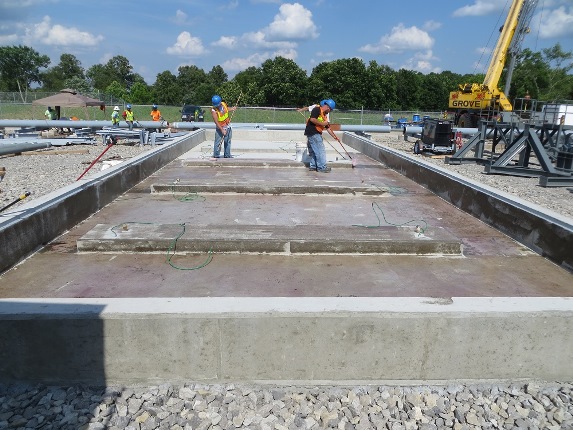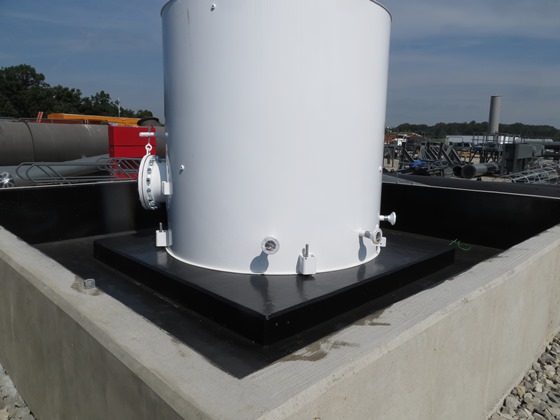Located near the Marcellus and Utica shale plays, the town of Barnesville, Ohio, is at the heart of the burgeoning U.S. natural gas industry. When MarkWest Energy began developing plans for a new gas compressor station in the area, they wanted construction solutions they could both trust and install quickly — allowing them to take advantage of reserves as soon as possible!
MarkWest knew it needed nine new secondary containment liners for its compressor station to protect against abrasion, impact, and corrosion, and the liners had to be installed on site in the field. The system also needed to be flame retardant. Based on the diverse requirements and the time crunch, the client was insistent on finding a coatings contractor they could trust.
“They checked into our background before even offering us an opportunity,” said Dennis Davidson, president of Mid-America Coating Systems, which was chosen to install the system. “They saw that we had a good reputation.”
That reputation was quickly put to the test.
“Being new construction, everyone is in a hurry,” Davidson explained. “We were given a one-week period to complete the project.”
Polyurea Boosts Flexibility
Based on the requirements, Davidson recommended the Rhino Extreme 11-50 FR system from Rhino Linings for the job. The system is a Class 1 fire-rated, elastomeric polyurea.
“The Extreme is actually designed for containment-type applications,” Davidson explained. “That’s due to its chemical resistance and ease of application. It’s flexible and remains elastic. Because it is a polyurea, it can be applied in high humidity or low temperatures. It cures quickly, which was also important since the construction schedule was tight.”
The ability to be applied in high humidity was particularly critical, since the job was completed during a sweltering Ohio summer. Precipitation was not an issue for the week-long project, but products had to be compatible with hot and humid application conditions.
Planning for Success
The toughest part of the job for Davidson’s four-man crew was likely the planning stage. For starters, the 5,226-square-foot (485.5 m2) jobsite was very remote with no utilities on site. As a result, the Mid-America Coating Systems crew brought in a 50-kW John Deere generator to supply power for their various tools, along with a rotary screw air compressor from Eaton with an air dryer. Similarly, water had to be brought in to feed their 4,000-psi (27.6 MPa) Honda pressure washer. All of the equipment was mounted inside a 36-foot (11.0 m) mobile trailer set up at the site.
“We had to make sure we parked our trailer so that it wasn’t in the road since they had semis coming in and out,” Davidson said.
Communication was also a priority from the onset since so many other trades were simultaneously working at the same location.
“This was a new construction project with about 100 people working all over the site every day,” Davidson said. “And our containment areas were also scattered across the jobsite, which required us to work around trades of all kinds.” All adjacent areas not receiving the lining system had to be covered and protected, including nearby equipment and machinery for other trades, using plastic and tape before any of the crew’s work could begin.
Personal protective equipment (PPE) was also a key part of the crew’s plan, including the regular usage of coveralls, gloves, steel-toed boots from Red Wing, and Honeywell’s North respirator cartridges.
The pit containment area, however, had even further requirements. “Because it was 8-foot [2.4 m] deep, it is considered confined space,” Davidson said. “For those, OSHA [Occupational Safety and Health Administration] requires the use of full-face, air-supplied respirator masks and a full-body harness with a safety line. Safety personnel were also required to supervise that portion of the operation and be available for extraction if needed.”
Spraying Around Other Trades
With PPE gear on and a plan in place to navigate around the other trades, the crew got to work quickly on each of the nine containment areas. Even though the substrate was new concrete aged 28 days, pressure washing was still a requirement to start the job.
“Even though it was new concrete, it was dirty from other trades laying materials and dragging mud,” Davidson explained.

Once each area was pressure washed, the concrete surfaces in that area were primed with Rhino’s two-component Primer 101. The primer, a 100-percent solids epoxy, was rolled out at ~8 to 10 mils (203.2‒254.0 microns). It dried quickly, with a pot life of only 10 to 15 minutes. The sealing primer has zero volatile organic compounds (VOCs) and has excellent moisture tolerance, according to the manufacturer.
“You’ve got two people applying the primer, with one individual doing nothing but mixing because it’s got such a short pot life,” Davidson said. “He then distributes it to the two people rolling it out. And once you put the primer on, you don’t want to even let it set overnight because you don’t want any dust to get on it. There’s also potential for rain or dew, and you can’t spray over that. You prime it, wait maybe 30 minutes or so, and then apply the polyurea.”
From there, 60 to 80 mils (1,524.0‒2,032.0 microns) of all-black polyurea was sprayed onto each of the areas using the AP-2 spray gun from Polyurethane Machinery Corp. (PMC). Typically, only one crew member would spray at a given time, while a second worker — the “hose puller,” as Davidson called him — would make sure the hose stayed out of the way. Meanwhile, a third crew member was in the trailer to monitor all of the equipment.
“In the event that something malfunctioned, they could shut everything down, if needed,” explained Davidson, who supervised the crew as they performed their tasks. “We’re very safety conscious, so we always have someone monitoring the equipment.”
As it turned out, using the spray gun was the easy part of the spraying process. The complexity was navigating through all the other trades and getting them used to what spraying entailed.
“Overspray was constantly a major concern,” Davidson said. “We had welders working within 15 feet [4.6 m] of our spraying. There were several front-end loaders and two cranes operating every day, lifting building materials and pipes all around the site as we did our work. The workers’ vehicles were also scattered across the site. On two occasions, we had to stop working and move our entire operation to accommodate the other crews.”
As a result, organization was essential. Each morning, the crew had a safety meeting to determine which direction the wind was blowing, and then make sure there were no workers downwind or any parked vehicles in that direction.
“There was a bit of give and take,” Davidson said of the process. “Some contractors had to be in certain areas on a particular day, so we would choose another spot to work in.”
Fortunately, as the week moved forward, the other trades seemed to get the hint.
“After a couple days, everybody caught on,” Davidson said. “They figured out that wherever these guys are working, we don’t want to be downwind!”
In the Black
Despite the scheduling hurdles, Davidson’s crew successfully completed the job within a week, which kept construction for the entire compressor station on schedule.
As far as he knows, the MarkWest site is now up and running and operating in the black — just like the polyurea.
“They were happy with it,” Davidson said of the client. “No complaints whatsoever. They remarked about how nice it looked. I think they were partly just happy to see us go!”
Fortunately, assuming the successfully installed lining system works as designed, the operator shouldn’t need another coatings crew at those areas for quite some time.
